
The Himalayan Mountains are a small wonderland of many amazing, untapped resources and Nepal happens to be the country they call home. What many people abroad don’t know is that Nepal is actually a prosperous country with enormous natural resources, including majestic Himalayas, diversified flora and fauna, water, forest, and hydropower. And one of them is Annapurna Sanctuary.
While trekking in Nepal is famous worldwide, most people are still looking for the best destination for their vacation. Well, you don’t need to worry – we have covered you. We have prepared a draft of the Annapurna Sanctuary trek, which can be your next travel destination filled with rejoices, adventures, and risks.
Annapurna Sanctuary, aka Annapurna Base Camp, lies in the Annapurna region and is not an unknown destination for travelers – it is one of the most liked treks in Nepal. What makes this trek so great is that you’ll win some spectacular views and experience different altitudes and cultures.
You might have seen the pictures on social media from friends or colleagues who have just completed an awe-inspiring trekking adventure in the Annapurna Sanctuary. They look tired but satisfied, posing in front of a stunning panorama of snow-capped peaks. You can’t help but feel a little envious.
You may already be a seasoned trekker or starting to get interested in this kind of adventure. In either case, this guide is for you. We’ll take you through everything you need before embarking on the trek to Annapurna Base Camp, including how to get there, what to pack, where to stay, and what to expect along the way.
Table Of Content
- Table Of Content
- Overview of the Annapurna Sanctuary
- Essential Gear for Annapurna Sanctuary Trek
- How to Prepare for the Trek?
- How To Start Your Trek To Annapurna Sanctuary?
- Highlights and Activities Along the Trail
- Tips for Safe and Successful Trekking in the Annapurna Sanctuary
Overview of the Annapurna Sanctuary
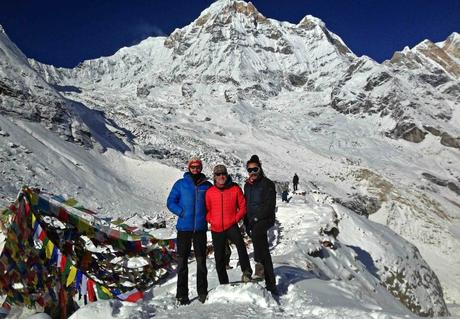
The Annapurna Sanctuary trek is a moderate/difficult hike that takes you through some of the most beautiful natural sceneries in the world. The tour takes you to the base camp of Mount Annapurna, the 10th-highest mountain in the world.
The trek is challenging, but it is worth it for the incredible views. With the start of the Sanctuary trail from Pokhara to the base camp, you will be widely welcomed by the Annapurna range, the Modi Khola River, and the dense tropical forest of rhododendron and Bamboo.
Similarly, the hospitable culture of the Magar and Gurung communities in the villages will melt your heart during the trip. The best time to go on the trek is from October to November. With a bit of preparation, you can make the most of your time on the hike and relish memories that will prevail for a lifetime.
Annapurna Sanctuary is situated 40 km north of the beautiful city of Pokhara which is a high glacial basing that sits at an altitude of over 4000 meters from the sea level. All in all, Annapurna Sanctuary is famous not only for its name but for its abundance of culture, climate, natural diversity, and adventures.
Essential Gear for Annapurna Sanctuary Trek
Embarking on an epic adventure to one of the world’s most scenic and rewarding trekking destinations: Annapurna Sanctuary or Base Camp is not accessible. You have to be well-prepared for your journey, and it’s important to make sure you have all the essential gear you’ll need.
Without proper gear and equipment, your hike would be worth it, as you might have expected.
Here’s an essential packing list to get you started:
– Waterproof hiking boots
– Waterproof jacket
– Warm hat and gloves
– Sleeping bag
– Tent
– Trekking poles
– Sunscreen
– Insect repellent
– First-aid kit
– Snacks and energy bars

How to Prepare for the Trek?
After you’re psyched to trek to Annapurna Sanctuary, it’s time to start preparing for the journey. The most important thing is getting in shape since your physical energy is mandatory to take this trek. Start by gradually increasing the distance and intensity of your regular walks or runs. You want to avoid pushing yourself too hard or fast and ending up with an injury that sidelines you on the trek.
In addition to your physical preparation, you’ll also need to do some mental prep. Trekking can be challenging, both physically and mentally. Make sure you’re comfortable with heights and aren’t afraid of exposure. The more difficult the trek, the more critical it is that you’re prepared for what lies ahead.
The last thing you want is to be miserable on vacation because you weren’t adequately prepared. So take the time now to get yourself in good shape—both physically and mentally—and you’ll be ready for an adventure of a lifetime.
Besides, you should have your insurance before the expedition. There are medical, life, and travel insurance available; you can count on anyone as per your choice.
Popular Routes in the Annapurna Sanctuary
There are a few different routes you can choose to travel before taking to Annapurna Base Camp. Here’s a look at the three most popular:
1. The Modi Khola Route: This is the shortest and most popular route, leading trekkers from Pokhara to the Annapurna Sanctuary in just six days.
2. The Jomsom Route: The longest but most varied route, the Jomsom Route winds its way from Pokhara to Jomsom and then on to the Annapurna Sanctuary.
3. Kande and Ghandruk Route: They are the best routes to Annapurna Sanctuary if you do not want to assimilate your ways with other treks. But if you’re going to extend your hike to Poon Hill trek, you can start from Nayapul – it takes 8-10 days for the entire trek.
Here is a complete breakdown of the route from Pokhara to Annapurna Base camp that you can opt for. Let’s dig deep into it and see the subsidiaries of the spots you will be walking across.
Pokhara To Annapurna Base Camp
Day 1Pokhara to Nayapul On Bus and Nayapul to Ulleri by trekking
Day 2Ulleri to Ghorepani Trek
Day 3Ghorepani to Poon Hill/Ghorepani to Tadapani Trek
Day 4Tadapani to Sinuwa
Day 5Sinuwa to Deurali
Day 6Deurali to Annapurna Base Camp(ABC)
Day 7ABC to Bamboo/Sinuwa
Day 8Bamboo/Sinuwa to Ghandruk Trek
Trekking from Pokhara to Annapurna Base CampHow To Start Your Trek To Annapurna Sanctuary?
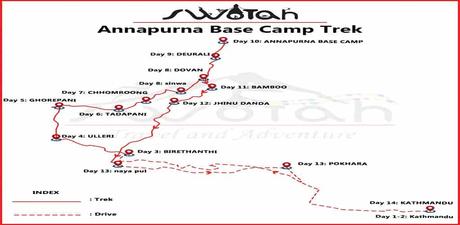
Kathmandu to Pokhara
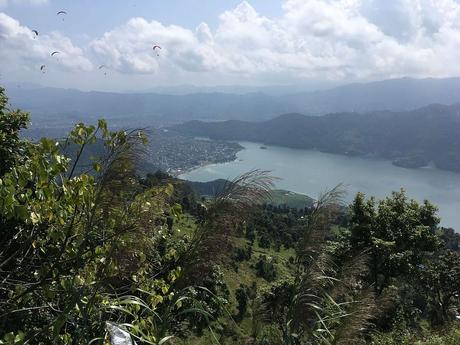
If you are an International traveler, you must get off at Tribhuwan International Airport in Kathmandu. Make sure your visa service is valid until the last day of your stay in Nepal. You can get a Nepal entry visa at your nearest Nepalese embassy or consulate.
Pokhara to Nayapul/ Nayapul to Ulleri
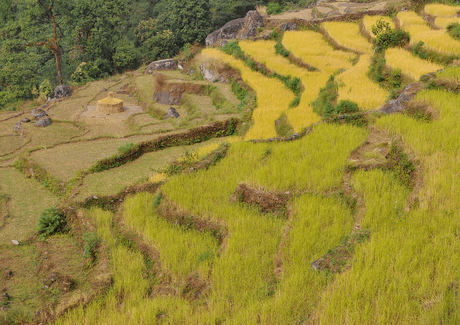
Your first step of the Annapurna Sanctuary Trek starts from Pokhara. You will take a bus/taxi to Nayapul from Pokhara Buspark. As you set off for Nayapul, you will pass through places like Phedi, Naudanda, Kande, and Lumle.
After that, you set up your trek to Ulleri. After a few hours of hiking, you will reach your station.
Ulleri to Ghorepani
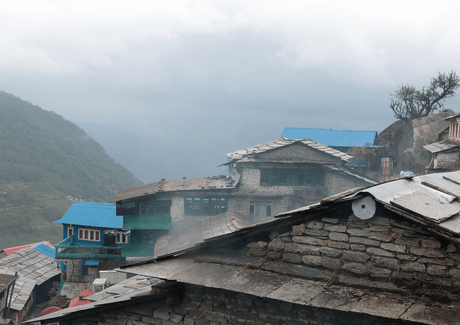
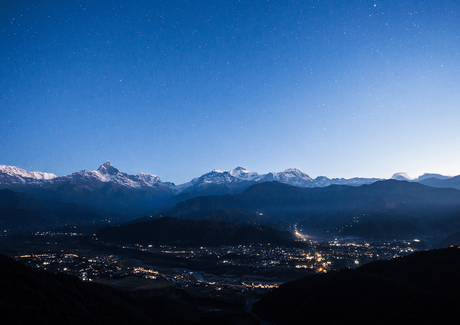
It takes around 5 hours from Ulleri to reach Ghorepani; if you start your hike in the morning, it’s possible to get the spot in the afternoon.
The majestic view of the Annapurna range, which you missed in Ulleri, can be quenched in Ghorepani. If you are hungry, you can find several lodges and tea houses for meals or lunch.
Ghorepani to Poonhill
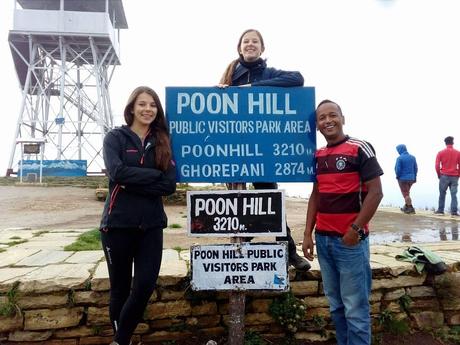
It’s a short distance from Ghorepani to Poonhill. You can reach Poonhill in 45 mins or more, depending on how fast you walk. Poonhill is home to several indigenous communities like Magars and Gurungs. It sits at an altitude of 3,210 meters and is perfect for witnessing the sunrise and sunset.
Tadapani to Sinuwa
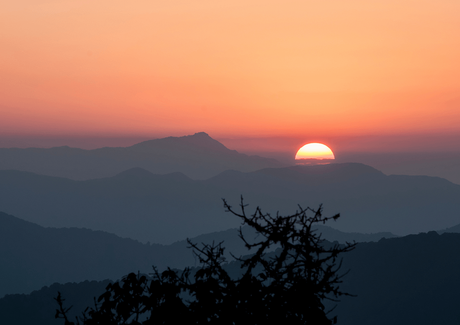
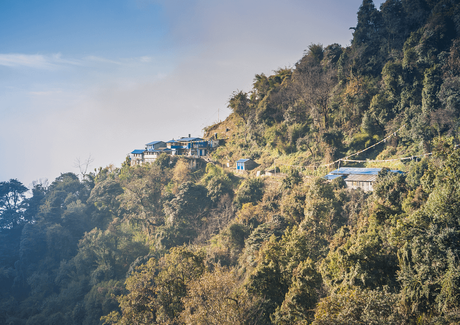
To reach Sinuwa, you will have to cross a river bridge and walk downhill for an hour, where you will reach a place called Komrong. After about two and a half hours of walking, you get to Chomrong, after which you will have to take more steps for around one and a half hours downhill to reach Sinuwa.
You can stay overnight in Sinuwa.
Sinuwa to Deurali
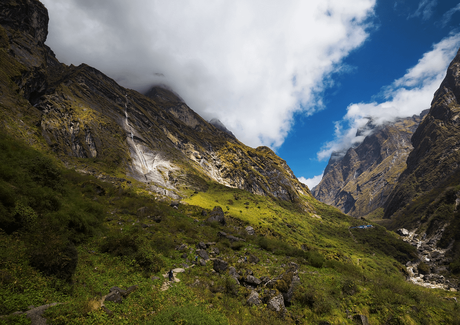
If you start your hike from Sinuwa early in the morning, you can reach Deurali by afternoon. You will have to cross several spots like Bamboo, Dovan, and the Himalayas while getting to Deurali. It takes around one and a half hours to reach Bamboo and 50 mins more from there to get to Dovan.
From Dovan, you will have to cross a dense forest uphill across the Himalayas for 3 hrs, and finally, you will be at Deurali, where you can stay overnight.
Deurali to MBC And ABC
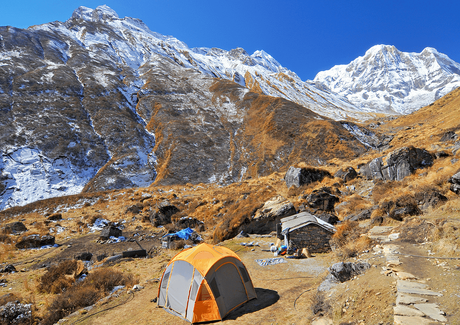
This is the final phase of your route to reach Annapurna Base Camp. It takes nearly 3 to 3.5 hrs to get to the base camp from Deurali. You will walk across the Machhapuchhre Base Camp to reach the spot. Most of your trek in this phase will be on flat parts with some uphill landscape, and you will be welcomed by the broad arms of Annapurna Base Camp at 4,130 meters.
You will see the scenic beauty of peaks like Machhapuchhre, Annapurna South, Annapurna I, Annapurna III, Hiunchuli, Gangapurna, and Gandharvachuli from the Base Camp.
Annapurna Sanctuary to Bamboo/Sinuwa
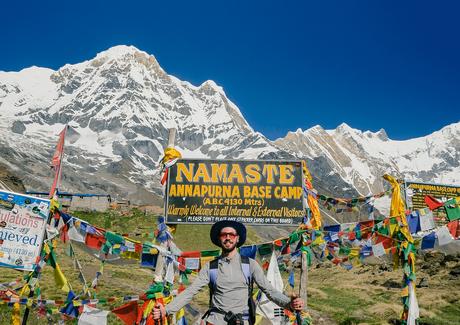
Returning to Bamboo and Sinuwa is the first step of your descent from Annapurna Base Camp. You will directly move to Bamboo crossing the stops like Deurali and Bamboo.
Bamboo to Jhinu Danda
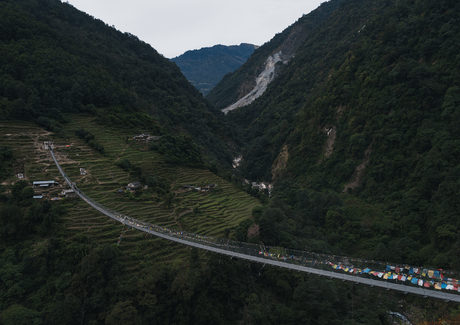
You will need to go through both an uphill and downhill trek from Bamboo to reach Jhinu Danda. It would be best if you walked for a few hours uphill before reaching Kuldighar, and from there, you will have to take a downhill hike to Chhomrong Khola. From there, you will be heading to Jhinu Danda, where you will stay overnight.
Jhinu Danda to NayaPul
It’s the last phase of your Annapurna Sanctuary trek. From Jhinu Danda, you will head directly to Nayapul, the station from where you started the trek. After reaching Nayapul, you will hire a bus or taxi to return to Pokhara before you head home.
Highlights and Activities Along the Trail
The Annapurna Base Camp trek is a fantastic experience and one that you will never forget. Here are some of the highlights and challenges that you can expect.
Highlights
- The stunning views of the Himalayas
- The friendly locals
- Sunrise/sunset and
- The wide range of rhododendron forests.
Challenges
- The problematic terrain
- The high altitude and
- The fact that you will be trekking for several hours each day.
Tips for Safe and Successful Trekking in the Annapurna Sanctuary
One of the best things you can do to prepare for your trek is to get your gear in order. Make sure you have the right backpack, hiking boots, and layers for the cooler temperatures at higher altitudes. It would be better if you take a hiking pole or two to help with the uphill sections.
Another important tip is to ensure you’re acclimatized to the altitude before starting the trek. The Annapurna Base Camp trek brings you an environment of 4,130 meters (13,545 feet), so it’s essential to make sure that your body adjusts to it. The best way to do this is to spend a few days in Pokhara (at an altitude of 910 meters/2,992 feet) before starting the trek. This will allow you to get used to the thin air and reduce your chances of altitude sickness.
Finally, make sure you’re well-hydrated before starting the trek. Drinking plenty of water will help prevent altitude sickness and make the hike more enjoyable since you’ll be less thirsty. I also recommend carrying a water filter or purifier to refill your water bottle from streams along the way.
Accommodation Facilities In Annapurna Sanctuary Trail
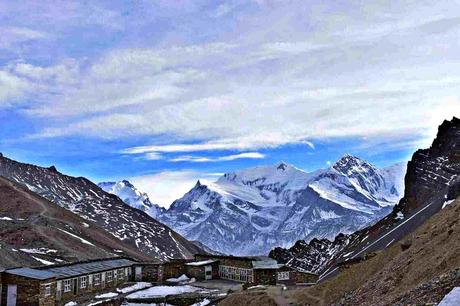
Three main types of accommodation options are available along the trail to Annapurna Base Camp: tea houses, camping, and homestays.
Tea houses are the most common accommodation type and can be found in even the most remote villages. They typically consist of a small room with two beds and sometimes an attached bathroom. The prices vary depending on the location and amenities, but they are generally very affordable.
Camping is another popular option for trekkers. A few companies offer guided camping tours, or you can choose to go it alone. If you opt for the latter, you will need to carry all of your own gear, which can be quite heavy. That said, it is a great way to immerse yourself in the wilderness and get away from the hustle and bustle of the tea houses.
Homestays are becoming increasingly popular in Nepal and offer a unique cultural experience. You will have the opportunity to live with a local family and learn about their way of life. The cost of a homestay includes meals and usually starts at around $10 per night.
Cost Required To Trek Annapurna Sanctuary
The cost for Annapurna Sanctuary Trek might differ depending on what activities you choose during the plan. Generally, it takes around $1000 for the complete hike from Pokhara to Annapurna Base Camp.
Your price may vary from gear and visa fees to the prices put on during your stay for food and accommodation. Let’s see the detailed information regarding how much money it will cost for a complete Annapurna Sanctuary trek.
Visa Fees
One of the most delicate things to remember while in Nepal is your Visa. You will need a valid visa to stay here which you can get from your nearest Nepalese embassy.
There will be multiple options for visa service. You can obtain a 30-day valid visa for $25-$30 or a multiple-entry visa valid for 90 days, which will cost around $100-$125.
Entry Fees And Permits
You cannot enter the Annapurna region without a permit. You will need entry permits like TIMS Card And ACAP Permit.
The cost of a TIMS Card is around 2000 NPR ($17). There are discounts for group travelers, 1000 NPR ($8) per person. Similarly, you will have to get an ACAP permit, which costs 3000 NPR ($25). You can obtain your permit from the Nepal Tourism Board.
Transportation Cost
You will have to allocate your budget for transportation. As soon as you land in Kathmandu, you will head to Pokhara in a rented vehicle or flight. The bus might charge around 3000 to 5000 NPR depending on the luxury of their services.
Similarly, flights cost from $30 to $150, depending on your chosen services.
Besides reaching Pokhara, you also should remember to have money in your pocket to travel around the city’s subsidiaries, i.e., Pokhara to Nayapul cost starts from 4000 NPR in a privately rented vehicle. If you want to hire a big car like Sutlej Bus for the group, it costs around 14,700 NPR.
Food Cost
Food costs can fluctuate, directly proportional to the time you stay on the Annapurna Base Camp trek. Generally, the average food cost will be around $500 to $700, including your three meals a day, breakfast, and water, if you are on a 14-day trek. But if you are on a short or long day’s trek in Annapurna Sanctuary, then the price will increase or decrease accordingly.
Lodging Cost
Lodging cost details here include your lodging from Pokhara. After you reach Pokhara from Kathmandu, you will need to find the best accommodation services. Several hotels and lodges provide different hierarchies of services. If you choose to opt for medium scaled lodges, the price will be 1500 to 2500 NPR per night. If you are luxury studded, you can choose sophisticated hotels that might cost you more than 5000 NPR per night; but the choice is yours.
Insurance Cost
Insurance is optional, but travel insurance might be mandatory if you are trekking under a travel agency. Travel insurance covers both the medical and emergency evacuation cost. The insurance’s worth will differ from agency to agency, depending on the services they provide to their clients. It would be better if you had insurance before your travel to any destination.
Challenges of Annapurna Sanctuary Trek
While the Annapurna Sanctuary trek is considered one of the most loved treks in the world, it is also very challenging. The hike can be as smooth as a short trek for regular hikers, but it is challenging for passive trekkers. That’s why we suggest every traveler be well-prepared before they take this trekking package.
Here are some of the challenges you might face during the Annapurna Sanctuary Trek:
Rugged Routes
The complicated pathways to Annapurna Base Camp are a challenge you might face. While the base camp is situated 40km north of the central city of Pokhara, modernization is not the thing to be expected. The routes are rugged though you will be walking through seasonal roads at some places. Be ready to boot up with your gears and use them more for safe travel here.
Climate And Temperature
If you are traveling to Annapurna Sanctuary in the winter season, one thing you must be ready to face is cold. Winter in the Himalayas can be life-threatening, and the temperature will likely fall below 0 Degrees Celsius. So buckle up your warm clothes and sleeping bags. Also, remember to have hot water to keep your body warm and hydrated.
High Altitude And Illness
While Annapurna Base Camp is at 4,130 meters above sea level, many travelers are highly endangered by altitude sickness. If you have yet to go to high altitude before then, it is the prominent thing you should be preparing for. Make sure you carry a first aid kid with you, and if your body says no, return to a lower altitude.
You’re now fully prepared to trek at Annapurna Base Camp. While it’s definitely not a walk in the park, if you’ve followed this guide and taken the necessary precautions, you should be ready for an unforgettable adventure. Enjoy the stunning views, take lots of pictures, and make plenty of memories—this is one journey you’ll never forget.
